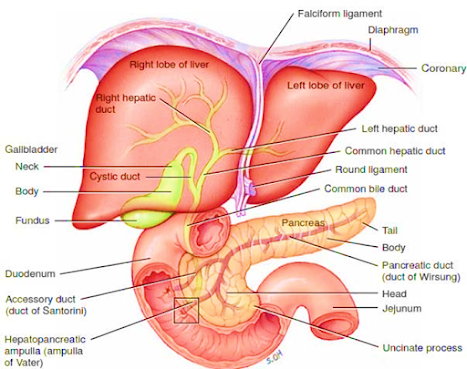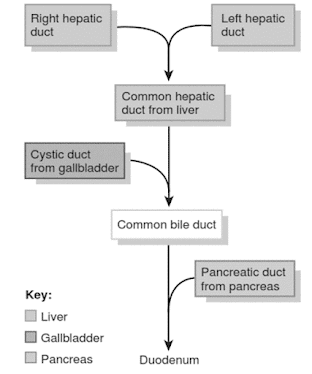The Pancreas
• A retroperitoneal gland
• About 12–15 cm long and 2.5 cm thick
• Lies posterior to the greater curvature of the stomach
• Consists of a head, a body & a tail
• Usually connected to the duodenum by two ducts
• Head – Expanded
portion of the organ near the curve of the duodenum
• Superior to and to the left of the head are the central
body and the tapering tail
• Larger ducts
– Pancreatic duct (duct of Wirsung)
– Accessory duct (duct of Santorini)
• Pancreatic juices are secreted by exocrine cells into
ducts
• Convey the secretions into the small intestine
• The pancreatic duct joins the common bile duct from the
liver and gallbladder
• Enters the duodenum as a dilated common duct called the hepatopancreatic ampulla (ampulla of Vater)
• The ampulla opens on an elevation of the duodenal mucosa
known as the major duodenal papilla
• The passage of pancreatic juice and bile – Regulated by a
mass of smooth muscle known
as the sphincter of the hepatopancreatic
ampulla (sphincter of Oddi)
Histology
of Pancreas
• The pancreas is made up of small clusters of glandular
epithelial cells
• Acini
– About 99% of the clusters – acini
– Constitute the exocrine portion of the organ
– Secrete a mixture of fluid and digestive enzymes –
pancreatic juice
• Pancreatic islets
– The remaining 1% of the clusters, called pancreatic islets
(islets of Langerhans)
– Form the endocrine portion of the pancreas
– Secrete the hormones glucagon, insulin, somatostatin &
pancreatic polypeptide
• Endocrine pancreatic islets (islets of Langerhans) secrete
hormones
• Exocrine acini secrete pancreatic juice
Secretions
of Pancreas
Pancreatic juice
• 1200–1500 mL of pancreatic juice
• Clear, colorless liquid
• Consists of water, some salts, sodium bicarbonate, and
several enzyme
• Sodium Bicarbonate – Buffers acidic gastric juice in chyme
• Stops the action of pepsin from the stomach
• Creates the proper pH for the action of digestive enzymes
in the small intestine
• Pancreatic juice
contains enzymes digest:
– Starch – Pancreatic amylase
– Proteins – Trypsin, chymotrypsin, carboxypeptidase, and
elastase
– Triglycerides – Pancreatic lipase
– Nucleic acids – Ribonuclease & deoxyribonuclease
• Enterokinase
converts trypsinogen to trypsin
• In turn, trypsin acts on the inactive precursors



